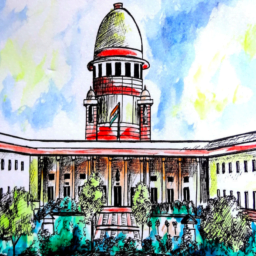INTRODUCTION
Bonded labour, often known as peonage, is a type of forced labour in which employees are obliged to work in order to repay a debt. In exchange, workers receive little or no remuneration, in some cases none at all. Most of the times, the money earned by them through working for many sleepless nights and days goes to pay off their loans and debts. There is an element of compulsion which binds these people to work. These people work constantly despite the sufferings of extreme exploitation and torture. These people are not treated as human beings but more like animals. If by any chance, they try to quit and leave their work, they have to bear the consequences of coercion and violence. It, therefore, becomes statistically important to understand and contemplate why and how this hounding practice of bonded labour started in India and in many parts of the world and why this activity persists till the present day.
ORIGINATION OF BONDED LABOUR IN INDIA
Since time immemorial, India has had the harrowing practice of casteism[1]. India’s casteism is the world’s longest surviving social hierarchy. In juxtaposition, the United States has the condemning dogma of racism. Scholars have described this pernicious practice to be about 2000 years old. The practice of casteism is much older than the practice of racism and is deeper rooted. The division of people in the society in accordance to caste is justified by some as per the doctrine of karma and the belief that a person’s deeds in his/her life determines his/her place in the society.
In many parts of rural India, the people belonging to the lower castes are still completely ostracized by the people of the higher castes. The lower caste people are made to believe that they are only there to serve the upper caste people. This detrimental practice leads the lower caste people to consider themselves inferior. The caste is a big issue in India and this is a major reason why a large number of lower caste people come in the pincer grip of this haunting practice of forced labour. An underpinning reason for the bonded or forced labour is the categorization of people in accordance with their status in the social stratum. The full-fledged practice of forced labour was established in the Mauryan Period. The Constitution of India guarantees its citizens the right to live as a respectable citizen.
A sample survey was carries out in Bihar by the AN Sinha Institute of Social Studies, Patna and the Internatonal Labour Organisation, Geneva in twelve villages spread across 12 districts of Bihar. The findings of that survey were both shocking and disheartening as it was observed that a very high proportion of labourors work as bonded laboureres. Around 33 percent of agricultural labourers who formed 45 per cent of sample households are attached to particular employees and the rest of them are casual labourers. About 32 per cent of the attached labourers had to clear the debts taken by them from their employers before they could give up working. It was also observed that casual labourers were also bonded in feudal tenancy terms.
The above mentioned survey analysis which was conducted in 1981-82 shows that even after the passage of the Bonded Labour System (Abolition) Act, 1976 by the parliament, the problem bonded labour still persisted though it was claimed by the government that the concept of bonded labour had been abolished.
A bonded labourer as defined by the Bonded Labour Act is “a labourer who incurs or is presumed to have incurred a bonded debt.” While, a bonded debt can be defined as “an advance obtained, or presumed to have been obtained by a bonded labour, who is, under the bonded labour system”. In a bonded labour system, the forced or partially forced labour enters into an an agreement with the creditor to the extent that his or her family member lose the right to opt any other employment and move freely throughout the country. They have no option but to work and serve the creditor for nominal and sometimes no wages also. Nominal wages refer to the wage which is less than the minimum wages fixed by the government in relation to same or similar labour.
In the case of Asiad Bonded Labour Case[2], Justice P.N. Bhagwati made the “compulsion to work for minimal wages” the uppermost criteria to define the Bonded Labour System. Through this definition, Justice Bhagwati counted the contract labourers and migrant labourers in the ambit of bonded labour. Here, he omitted the fact that a large population of agricultural labourers also comes in this category, who go through the worst pangs of hunger and poverty and still work for less than minimum wages.
When the government is questioned on such a sensitive issue, it outrightly claims at first that such a system does not exist in the country. It is not ready to acknowledge the phenomenon of bonded labourers. But the problem of bonded labour cannot be put under a veil as it is very much prevalent in the society till date. The bonded labourers are promised and assured of renumeration, food, clothing etc. but they are not provided with these amenities.
LAWS AND REGULATIONS TO ADMINISTER THE VIOLENCE AGAINST THE BONDED LABOURERS
The bonded labourers are also known as bandhua mazdoor, sewakia, kamia, saukia, janauri, etc. They are not considered as bonded labour by the government but as attached labourers. Forced labour violates the fundamental rights guaranteed to all the citizens by the Indian Constitution. Article 23(1) of the Constitution states that,” Traffic in human beings and beggar and other forms of forced labour are prohibited and any infringement of the provision shall be an offence which will be punishable by the law.”
The Bonded Labour System Abolition Act of 1976 is quite remarkable in that it recognizes (a) the overlap between forced labour and bonded labour in customary relationships and also (b) the manifestation of these relationships in contract labour and inter-state migration and (c) considers the nature of restraints suffered by the labourer as a result of the bonded or forced labour relationship, and makes all of these illegal.
THE CONDITIONS UNDER WHICH THE BONDED LABOURERS STRIVE TO WORK IN ORDER TO PAY THE HUGE AMOUNT OF LOANS
The problem of bonded labour affects men, women and children. Although, women and young children are treated additionally in a worse manner. The women go through extra hardships due to their social status as being subordinate to men. The children are also ill-treated as it is believed that they can be controlled easily. The persons are dehumanized and almost like a commodity which can be bought and sold. In some cases, a person can be a bonded labourer for months and in some cases, even for years until he or she pays off the debt. There is a physical boundation on their movement and their freedom to choose the job they prefer to do.
CONCLUSION
The bonded labour does not exist much in the urban areas. But its roots are still very much entrenched in the rural areas where the casteism is giving a huge weightage. The poorest households in the villages toil really hard but still are not successful in making the both ends meet. In those cases, the phenomenon of bonded labour again comes to the brim. The technological advancements and proper living conditions to the persons living below the poverty line should be provided so that they do not rely on the economically stable people for commodities. The banks should be welcoming to people of all economic strata and each person should be made acquainted with the proper rate of interests so that the poor people do not fall in the trap of the moneylenders and the landlords. A large number of bonded labourers have been absolved from the traps of bonds and even given compensation. A large number of bonded labourers were given jobs in government departments, given agricultural lands to start a new life of their own. They were also given the rehabilitation.
The passing of the Bonded Labour System (Abolition) Act of 1976 sought to abolish the slavery in all its forms. But the mere passage of the Act is only a formality. It needs to be brought in proper functioning so that the people are discriminated in such ways of forced or bonded labour. It is a kind of economic injustice which gives rise to such dreadful practices. The real solution to this problem lies in giving these people a life of dignity and should be made economically stable so that they do not fall into such traps again in any case.
Author(s) Name: Ishita Khandelwal (National Law University, Odisha)
References:
[1] Rishab Khare, ‘Bonded Labour In India: An Analysis’ (Mondaq, 21 January 2021) <https://www.mondaq.com/india/employee-rights-labour-relations/882222/bonded-labour-in-india-an-analysis> accessed 21 September 2021
[2] People’s Union For Democratic v. Union Of India & Others 1982 AIR 1473, 1983 SCR (1) 456
















